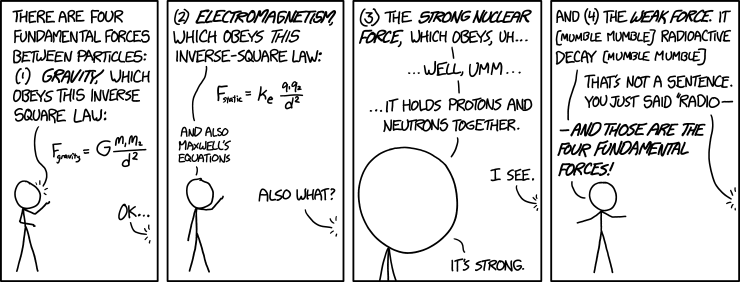Rather, since our world is governed by particle physics, welcome to our world! We’ve long been told that everything we see, everything we can touch is made up of little pieces. The smallest of these structural pieces would be atoms. There are a number of different kinds of atoms with different sizes and qualities, but there are even smaller pieces than that which make up those pieces. Particle physics is the study of these little pieces, their interactions, and the forces acting among them. Before getting into the really cool stuff and what theories of particle physics have in terms of real-life applications for the world, it is important that we have a pretty basic overview of these particles. These elementary subatomic particles can be broken into three groups:
- Quarks – These are the six basic particles that come together to form most of all of the matter in the universe. Two of the larger known particles that are of common knowledge are the proton and neutron. Protons and neutrons along with electrons which we will talk about later are what are commonly discussed to make up everything. Protons and neutrons are made up of only two kinds of quark. A proton is made up of two up quarks and one down quark whereas a neutron is made up of two down quarks and one up quark. In order to make any particle, you need a total of three quarks. Protons and electrons are known to have a +1 and -1 charge respectively. Quarks also carry charges, but they have fractional charges of either +2/3 or -1/3. When looking at the proton and neutron this makes complete sense. The proton has two ups and one down. From below, we know that means there are two +2/3 charges and one -1/3 charge. Adding these charges gives a sum of +1, the charge of a proton. Likewise, with a neutron there are two downs and one up. This results in two -1/3 charges and one 2/3 charge. The sum gives a charge of zero which explains the neutron’s neutral charge. The following are quarks and their respective charges:
- Up: +2/3
- Down: -1/3
- Charm: +2/3
- Strange: -1/3
- Top: +2/3
- Bottom: -1/3
- Leptons – The most familiar of these particles would of course be the electron, but the rest of these particles are extremely similar to the electron. They all have the same negative charge that the electron has, but they are all rarer and heavier except for the neutrino particles. Those are actually so light that their mass is practically indescribable and it is debated whether they actually have mass at all.
- Electron neutrino
- Muon neutrino
- Tau neutrino
- Electron
- Muon – Practically 200 times heavier than an electron
- Tau
- Gauge Bosons (force carriers) – These are by far the coolest in my opinion. These are called the force carriers because they are responsible for the fundamental forces at work in our world. The fundamental forces in the world are Strong Force, Weak Force, Electromagnetic, and Gravity. Gravity is an attractive force responsible for us keeping our feet on the ground. Electromagnetic force is between charged particles and the like. In all honesty, I do not really understand Strong and Weak force…
 So, in case you are wondering more about strong force and weak force, I’ve provided some links that go into a better and deeper explanation. For our purposes though, it is enough for now just to know they exist and are partially responsible for the way our universe works. As the xkcd comic above explains, strong nuclear force is responsible for holding protons and neutrons together. This is the strongest force, hence the name. The caveat is that the force is only effective over a very small distance. This is the same case with the weak force which is responsible for processes like beta decay and nuclear fusion which powers our sun. Without it, we would be in the dark.
So, in case you are wondering more about strong force and weak force, I’ve provided some links that go into a better and deeper explanation. For our purposes though, it is enough for now just to know they exist and are partially responsible for the way our universe works. As the xkcd comic above explains, strong nuclear force is responsible for holding protons and neutrons together. This is the strongest force, hence the name. The caveat is that the force is only effective over a very small distance. This is the same case with the weak force which is responsible for processes like beta decay and nuclear fusion which powers our sun. Without it, we would be in the dark.
- Photon – Speaking of being in the dark, photons are considered the particles of light. Don’t even let me get started with wave-particle duality in terms of light. Regardless of the position taken, the photon as a particle represents electromagnetic forces
- Gluon (8) – These are responsible for the strong force.
- W & Z Bosons (3) – These are responsible for the weak force.
- Higgs Boson – This is the famed “God Particle”. It was hypothesized back in 1960, but was just physically discovered in 2012. The reason why it is so important is that it proves the existence of the Higgs field which provides explanations for particles having mass and why the fundamental strong and weak forces only work over short distances.
So, there you go! That is the very basics of the particles bit of particle physics. Other topics that we will talk about soon include anti matter, accelerators, detectors, and the science behind the big bang. As always, feel free to ask any and all questions you may have and feel free to let me know!